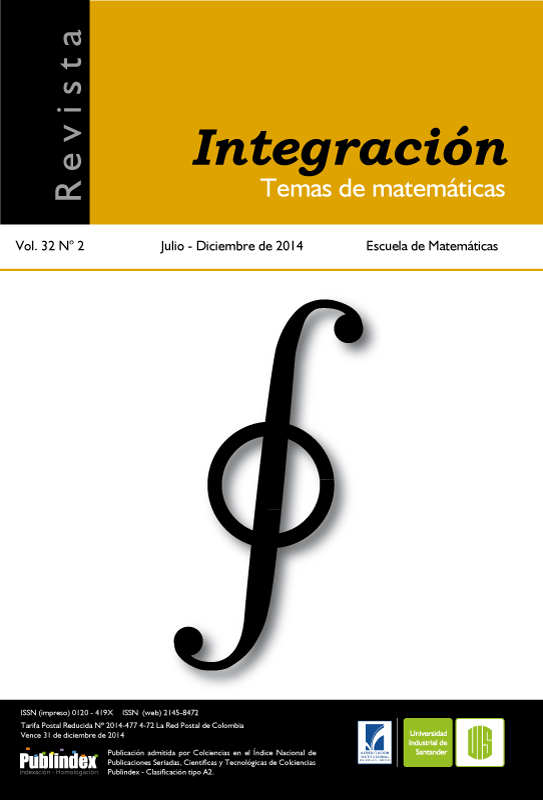Artículos científicos
Publicado 2014-10-31
Palabras clave
- Función matricial,
- operador de Fréchet,
- Fréchet diferenciable,
- método secante,
- ecuación matricial no lineal
- convergencia superlineal ...Más
Cómo citar
Macías C., M., Martínez, H. J., & Pérez, R. (2014). Sobre la convergencia de un método secante para ecuaciones matriciales no lineales. Revista Integración, Temas De matemáticas, 32(2), 181–197. Recuperado a partir de https://revistas.uis.edu.co/index.php/revistaintegracion/article/view/4382
Resumen
En este artículo desarrollamos una teoría general de convergencia de un método secante para resolver ecuaciones matriciales no lineales. Además, presentamos condiciones suficientes para que este método proporcione un algoritmo local y superlinealmente convergente.
Para citar este artículo: E.M. Macías, H.J. Martínez, R. Pérez, Sobre la convergencia de un método secante para ecuaciones matriciales no lineales, Rev. Integr. Temas Mat. 32 (2014), no. 2, 181-197.
Descargas
Los datos de descargas todavía no están disponibles.
Referencias
- Acevedo R., Pérez R. y Arenas F., “El método DL para resolver sistemas de ecuaciones no lineales”, Matemáticas: Enseñanza Universitaria 16 (2008), 23-36.
- Bittani S., Laub A.J. and Willems C., The Riccati equation, Springer-Verlag, Berlin, 1991.
- Davis J.G., “Numerical solution of a quadratic matrix equation”, SIAM J Sci and Stat. Comput. 2 (1981), no. 2, 164-175.
- Dennis J.E. and Schnabel R.B., Numerical methods for unconstrained optimization and nonlinear equations, Prentice-Hall, New Jersey, 1983.
- Dennis J.E. and Walker H.F., “Convergence theorems for least-change secant update methods”, SIAM J. Numer. Anal. 18 (1981), no. 6, 949-987.
- Golub H.G., Nash S. and Van Loan C., “A Hessenberg-Schur method for the problem AX + XB = C”, IEEE Trans. Automat. Control 24 (1979), no. 6, 909-913.
- Hashemi B. and Dehghan M., “Efficient computation of enclosures for the exact solvents of a quadratic matrix equation”, Electron. J. Linear Algebra 20 (2010), 519-536.
- Higham N.J., Functions of matrices theory and computations, SIAM, 2008.
- Higham N.J. and Kim H., “Numerical analysis of a quadratic matrix equation”, IMA J. Numer. Anal. 20 (2000), no. 4, 499-519.
- Higham N.J. and Kim H., “Solving a quadratic matrix equation by Newton’s methods with exact line searches”, SIAM J. Matrix Anal. Appl. 23 (2001), no. 2, 303-316.
- Kreyszig E., Introductory functional analysis with applications, Wiley & Sons, Canada, 1978.
- Lancaster P. and Rodman L., Algebraic Riccati equations, The Clarendon Press, Oxford University Press, New York, 1995.
- Martínez J.M., “On the relation between two local convergence theories of least-change secant updates
- methods”, Math. Comp. 59 (1992), no. 200, 457-481.
- Martínez J.M. and Santos S.A., “Métodos computacionais de otimização”, 20 Colóquio Brasileiro de Matemática, IMPA 1995, p. 87.
- Monsalve M. and Raydan M., “Newton’s method and secant methods: A long-standing relationship from vectors to matrices”, Port. Math. 68 (2011), no. 4, 431-475.
- Monsalve M. and Raydan M., “A secant method for nonlinear matrix problems”, Chapter
- of Numerical Linear Algebra in Signals, Systems and Control, P. Van Dooren et al. (eds.), Springer Verlag. 80, 2011, 387-412.
- Parks P.C., “AM Lyapunov’s stability theory–100 years on”, IMA J. Math. Control Inform. 9 (1992), no. 4, 275-303.
- Pérez R. y Díaz T., Minimización sin restricciones, Editorial Universidad del Cauca, 2010.
- Tisseur F. and Meerbergen K., “The quadratic eigenvalue problem”, SIAM Rev. 43 (2001), no. 2, 235-286.
